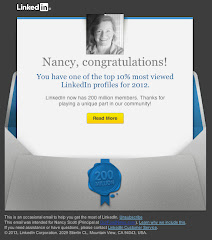Once upon a day – back when men were men and so were editors – the patriarch of the newspaper decided whether an event or happening was worthy news. He selected, based in part, on whether or not his readers “needed to know.” Sure, it was a somewhat subjective call, but that was the basic tenet -- the “need to know,” as defined by the editor. Not the desire to know, not the itch to know… the need to know.
Remember when your parents refused to tell you something because they said you didn’t “need to know that”? Same principle. Oh sure, newspapers carried opinion and entertainment stuff, too – right on the op-ed page and across from the comics page so everybody could differentiate entertainment from news. Not so today.
In the new century, stuff gets into the newspaper only if – and always when -- it will get repeated by some other paper or reap some broader attention. It doesn’t matter whether we, the readers, need to know it or not. We’re just the lab rats for “information.”
The Dingus case in point:
I mean, seriously…. "Does any reader NEED to know that some Dingus in Florida with 50 other Dingi in attendance is going to torch a certain book? Does anybody need to know that? Not unless they live next door [or dangerously close] to the Dingus in question. Seriously, folks.
And yet … over the past so-many weeks, what “news” organizations have been asking if their readers/listeners need to know this? En Oh En Ee. NONE. Every media voice – TV, radio, newspaper, online news, bloggers, etc. – jumped in to ride this Dingle Baby for all it was worth.
And what was it worth? The construction of faux catastrophe, with a possibility of widespsread mayhem , death, and increasing violence.
That’s the idea, of course, since today “news” isn’t about news at all. It’s about getting “eyeballs,” about pumping up readership, about not being “left out” of the spin, and, most of all, about pandering for money, pure and simple.
Not that I’m blaming editors, mind you. Geneva Overholser puts it well in her piece on the State of the American Newspaper. “Most of the foregoing litany boils down to money. America became obsessed with business, and newspapers did, too. John Carroll, editor of Baltimore's Sun, sees the larger changes when he looks back, past his 35-year newspaper career, to his alma mater, Haverford College. ‘Business is ascendant in this society to a degree it has not been in my lifetime,’ he says. ‘The best and the brightest from my college are all becoming investment bankers. When I went there, I'd never heard the term 'investment banker.' People all wanted to be journalists or doctors or college professors. But now--a lot of publishers and CEOs want an editor who talks about leveraging assets.’”
And that is how and why the Dingus became an international celebrity.
-- scrubbed by Marketing Brillo

